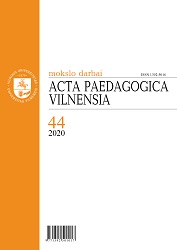Žemų mokymosi pasiekimų įveikos paieška: neurodidaktinės įžvalgos
Exiting from the Low Learning Achievement: Neurodidactic Insights
Author(s): Agnė Brandišauskienė, Aušra Daugirdienė, Jūratė Česnavičienė, Ramutė BruzgelevičienėSubject(s): Educational Psychology, Cognitive Psychology, Neuropsychology, Socio-Economic Research, Sociology of Education
Published by: Vilniaus Universiteto Leidykla
Keywords: low learning achievement; neurodidactic; social-economic-cultural context;
Summary/Abstract: Lithuanian schools face the challenge of low learning achievement. International and national studies show that the results of Lithuanian school students are not tantamount. There are significant differences among different groups: between boys and girls, between students from different social–economic–cultural backgrounds, different types of localities (cities, towns or rural areas), as well as learners of different languages (Lithuanian, Russian, Polish) (Lithuania. National and Regional Education 2019. Student Achievement Gap). It is clear that the spectrum of factors influencing achievement is wide-ranging, from decisions made by students themselves, the teachers, or the schools, to the ones made in the wider settings or (context) or by municipalities. They all demand scientific discussion, but in this article we focus on the organisation of the teaching/learning process in the neurodidactic context. The work is based on theoretical insights, the core of which is neuroactivation in the learning process as one of the fundamental elements of good teaching and successful learning. In striving for quick, yet not always successful, learning achievement, we do not engage students in an in-depth learning process. Therefore, we fail to arouse interest in the subject taught; the students’ acquired knowledge is not preserved for long and is not used when necessary. By focusing on the teaching/learning process, we can lay the foundations for positive change at the neural level. Searching for the causes of low learning achievement and ways to overcome them, it is important to refer to the findings of contemporary studies concerning the connections between teaching and learning processes with the neuro-structure of children’s brains. A reciprocal connection was identified when learning changes the architecture (structure) of the brain, which in turn affects learning and attaches particular importance to the teacher’s work. It is its nature that can influence how the neuro-structure of the student’s brain changes at the cellular level. Therefore, it is important to consider aspects related to the student’s brain activity in the teaching process, namely excitation, awareness, memory and information transfer. In this respect, it makes sense to continue the research and to conceptually discuss the educational dimension and teaching/learning strategies when working with low achievers.
Journal: Acta Paedagogica Vilnensia
- Issue Year: 2020
- Issue No: 44
- Page Range: 99-113
- Page Count: 15
- Language: Lithuanian

